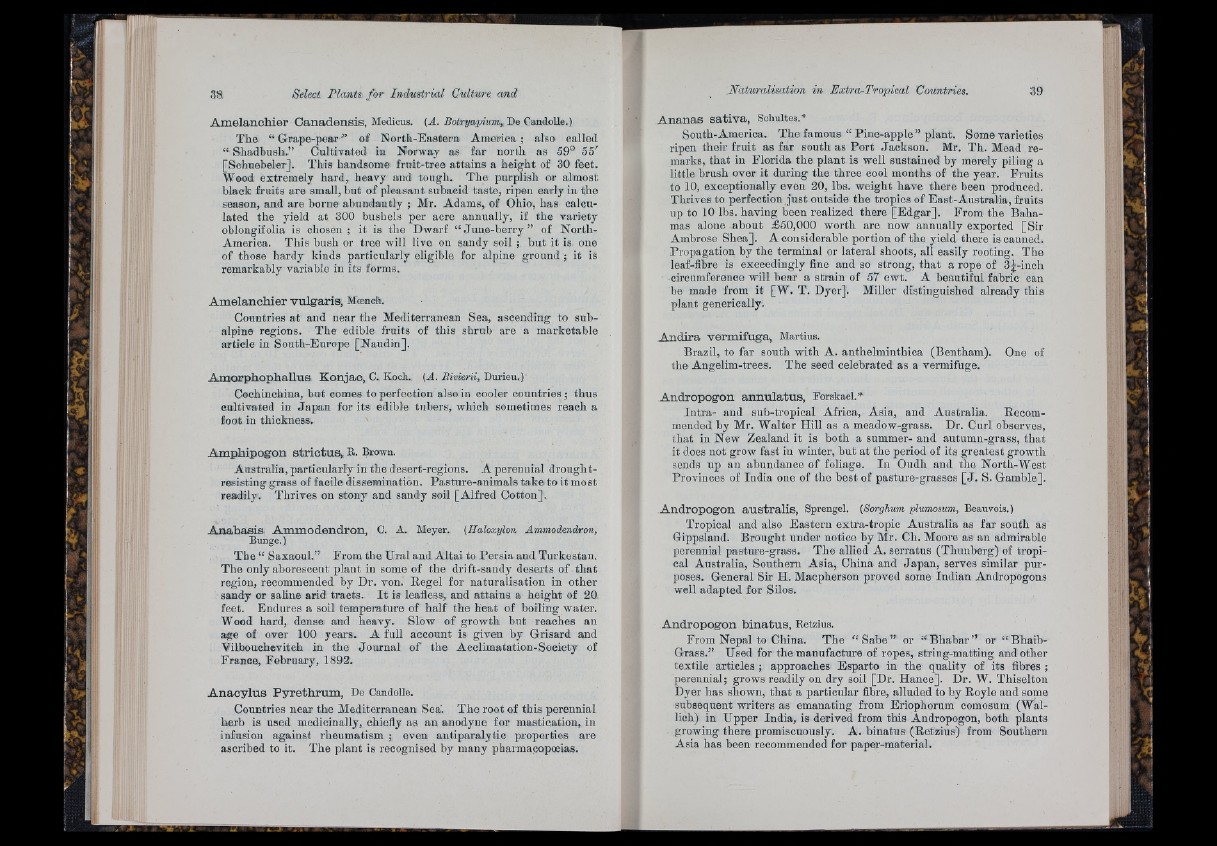
A m e la n c h ie r C a n a d e n s is , Medicus. {A. Botryapium, De Candolle.)
The “ Grape-pear •” of North-Eastern America; also called
“ Shadbusli.” Cultivated in Norway as far norUi as 59° 55'
[Schuebeler], This handsome fruit-tree attains a height of 30 feet.
Wood extremely hard, heavy and tough. The purplish or almost
black fruits are small, but of pleasant subacid taste, ripen early in the
season, and are borne abundantly ; Mr. Adams, of Ohio, has calculated
the yield at 300 bushels per acre annually, if the variety
oblongifolia is chosen; it is the Dwarf “ Ju n e -b e rry ” of North-
America. This bush or tree will live on sandy soil ; but it is one
of those hardy kinds particularly eligible for alpine ground ; it is
remarkably variable in its forms.
A m e la n c h ie r v u lg a r is , Moenoli.
Countries at and near the Mediterranean Sea, ascending to sub-
alpine regions. The edible fruits of this shrub are a marketable
article in South-Europe [Naudin].
A m o rp h o p h a llu s K onjac, C. Koch. (A. Bivierii, Durieu.)
Cochincbina, but comes to perfection also in cooler countries; thus
cultivated in Jap an for its edible tubers, which sometimes reach a
foot in thickness.
A m p h ip o g o n s t r ic tu s , R. Brown.
Australia, particularly in the desert-regions. A perennial drought-
resisting grass of facile dissemination. Pasture-animals take to it most
readily. Thrives on stony and sandy soil [Alfred Cotton].
A n a b a s is A m m o d e n d ro n , C. A. Meyer. (Haloxylon Ammodendron,
Bunge. )
The “ Saxaoul.” From the Ural and A ltai to Persia and Turkestan.
The only aborescent plant in some of the drift-sandy deserts of th a t
region, recommended by Dr. von. Regel for naturalisation in other
sandy or saline arid tracts. I t is leafless, and attains a height of 20
feet. Endures a soil temperature of half the heat of boiling water.
Wood hard, dense and heavy. Slow o f growth but reaches an
age of over 100 years. A full account is given by Grisard and
Vilbouehevitoh in the Journal of the Acclimatation-Soeiety of
France, February, 1892.
A n a c y lu s P y r e th rum , De Candolle.
Countries near the Mediterranean Sea'. The root of this perennial
herb is used medicinally, chiefly as an anodyne for mastication, in
infusion against rheumatism ; even antiparalytic properties are
ascribed to it. The plant is recognised by many pharmacopoeias.
A n a n a s s a tiv a , Schultes.*
South-America. The famous “ Pine-apple” plant. Some varieties
ripen their fruit as far south as Port Jackson. Mr. Th. Mead remarks,
that in Florida the plant is well sustained by merely piling a
little brush over it during the three cool months of the year. Fruits
to 10, exceptionally even 20, lbs. weight have there been produced.
Thrives to perfection just outside the tropics of East-Australia, fruits
up to 10 lbs. having been realized there [E d g a r]. From the Bahamas
alone about £50,000 worth are now annually exported [Sir
Ambrose Shea]. A considerable portion of the yield there is canned.
Propagation by the terminal or lateral shoots, all easily rooting. The
leaf-fibre is exceedingly fine and so strong, th a t a rope of 3|-inoh
circumference will bear a strain of 57 cwt. A beautiful fabric can
be made from it [W. T. Dyer]. Miller distinguished already this
plant generically.
A n d ira v e rm ifu g a , Martius.
Brazil, to far south with A. anthelminthica (Bentham).
the Angelim-trees. The seed celebrated as a vermifuge.
One of
A n d ro p o g o n a n n u la tu s , Forskael.*
In tra- aud sub-tropical Africa, Asia, and Australia. Recommended
by Mr. Walter Hill as a meadow-grass. Dr. Curl observes,
that in New Zealand it is both a summer- and autumn-grass, that
it does not grow fast in winter, but at the period of its greatest growth
sends up an abundance of foliage. In Oudh and the North-West
Provinces of India one of the best of pasture-grasses [ J . S. Gamble].
A n d ro p o g o n a u s tr a lis , Sprengel. (Sorghum plumosum, Beauvois.)
Tropical aud also Eastern extra-tropic Australia as far south as
Gippsland. Brought under notice by Mr. Ch. Moore as an admirable
perennial pasture-grass. The allied A. serratus (Thunberg) of tropical
Australia, Southern Asia, China and Japan, serves similar purposes.
General Sir H. Macpherson proved some Indian Andropogons
well adapted for Silos.
A n d ro p o g o n b in a tu s , Retzius.
From Nepal to China. The “ Sah e ” or “ B h ab a r” or “ Bhaib-
Grass.” Used for the manufacture of ropes, string-matting and other
textile articles ; approaches Esparto in the quality of its fibres ;
perennial; grows readily on dry soil [Dr. Hance]. Dr. W. Thiselton
Dyer has shown, th a t a particular fibre, alluded to by Royle and some
subsequent writers as emanating from Eriophorum comosum (Wallich)
in Upper India, is derived from this Andropogon, both plants
growing there promiscuously. A. binatus (Retzius) from Southern
Asia has been recommended for paper-material.